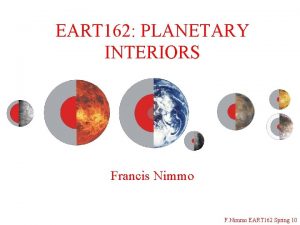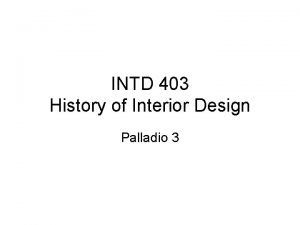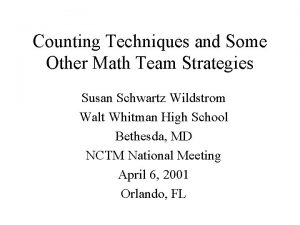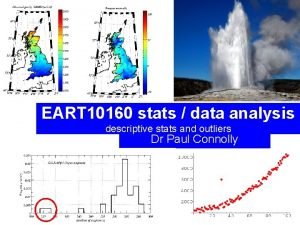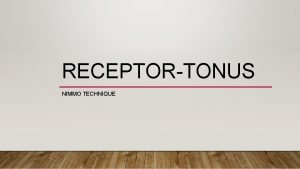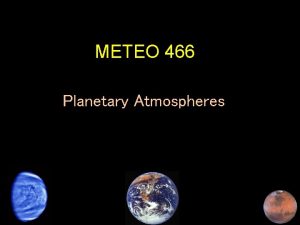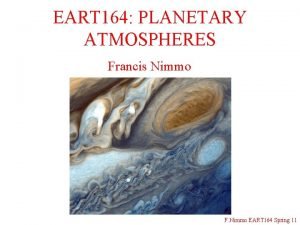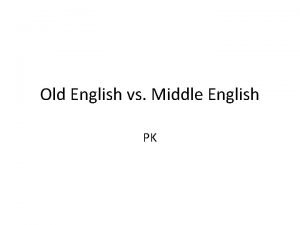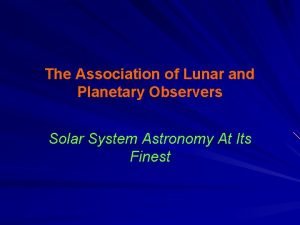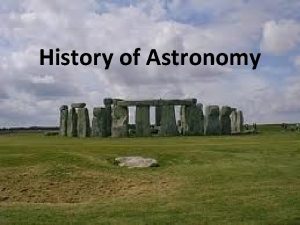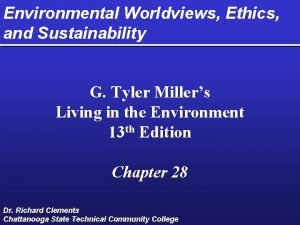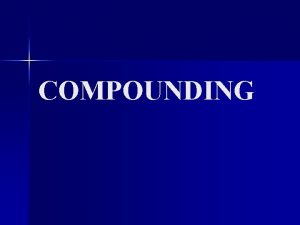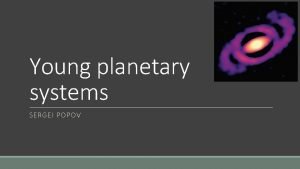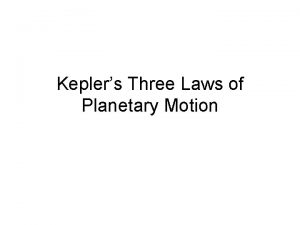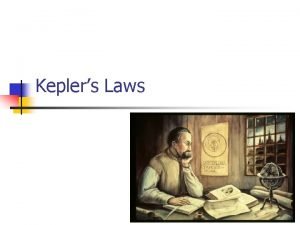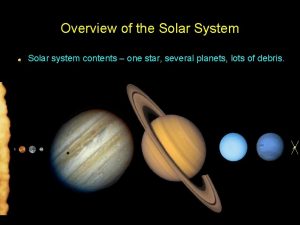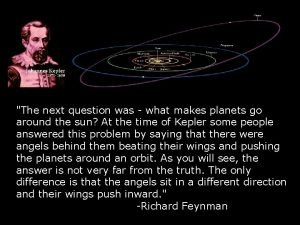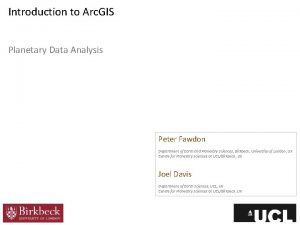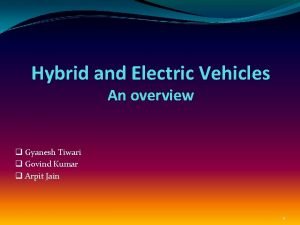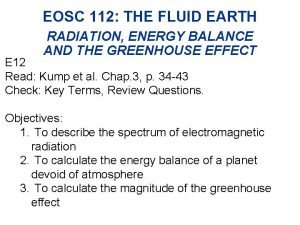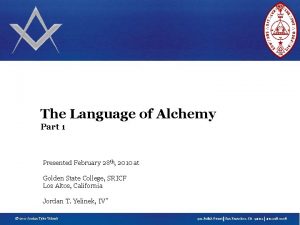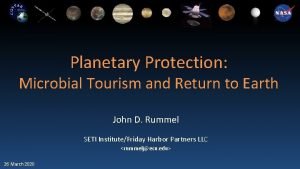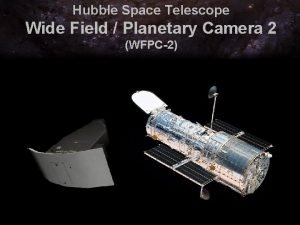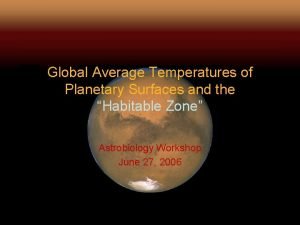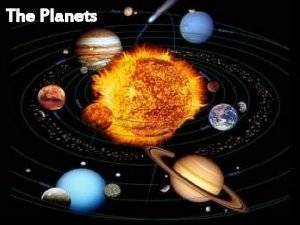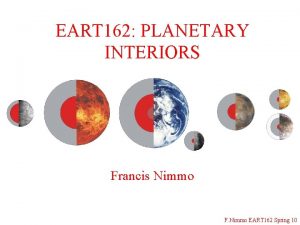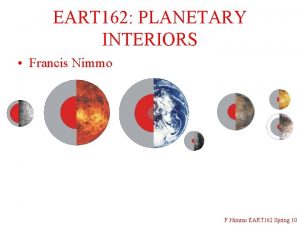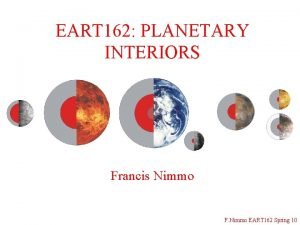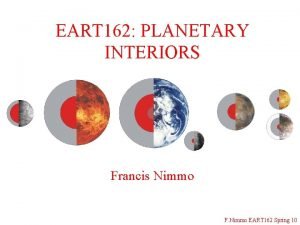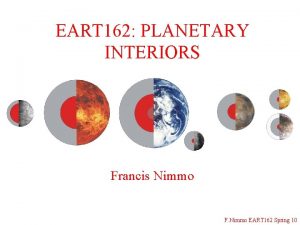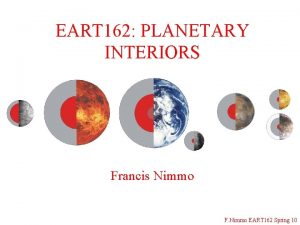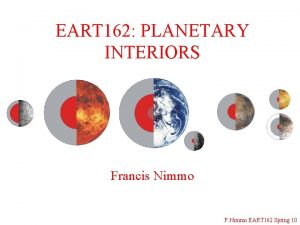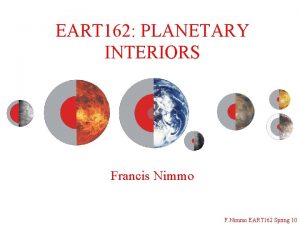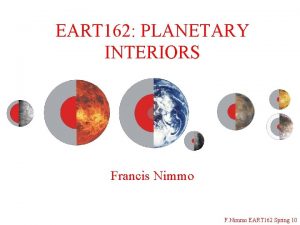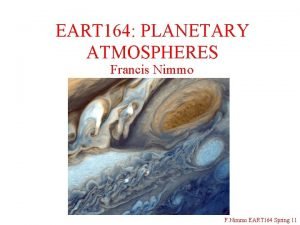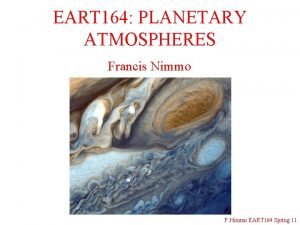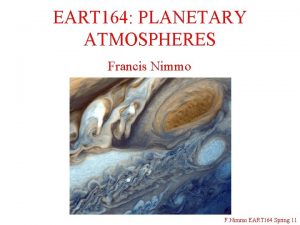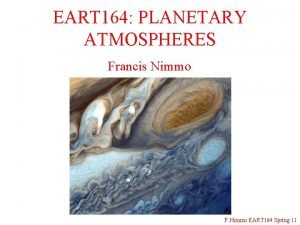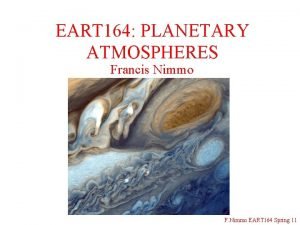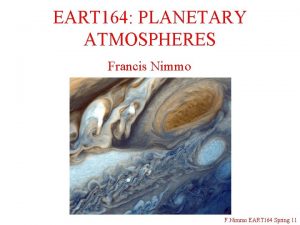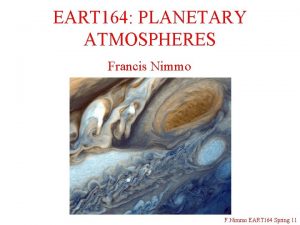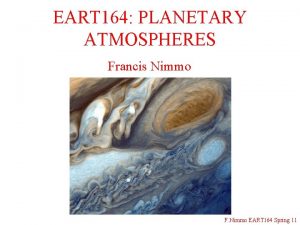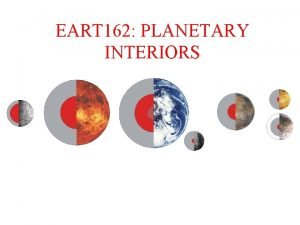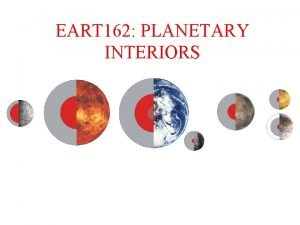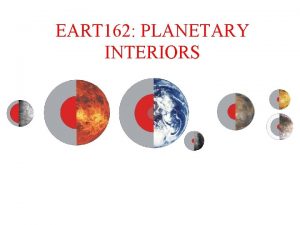EART 162 PLANETARY INTERIORS Francis Nimmo F Nimmo


































- Slides: 34

EART 162: PLANETARY INTERIORS Francis Nimmo F. Nimmo EART 162 Spring 10

Last Week • Fluid dynamics can be applied to a wide variety of geophysical problems • Navier-Stokes equation describes fluid flow: • Post-glacial rebound timescale: • Behaviour of fluid during convection is determined by a single dimensionless number, the Rayleigh number Ra F. Nimmo EART 162 Spring 10

This Week – Tides • Planetary tides are important for two reasons: – They affect the orbital & thermal evolution of satellites – We can use tidal effects to infer satellite moments of inertia (and thus internal structure) F. Nimmo EART 162 Spring 10

Recap – planetary shapes • For a rotationally flattened planet, the potential is: • This is useful because a fluid will have the same potential everywhere on its surface • Let’s equate the polar and equatorial potentials for our rotating shape, and let us also define the ellipticity (or flattening): a f c • After a bit of algebra, we end up with: Note approximate! a Remember that this only works for a fluid body! F. Nimmo EART 162 Spring 10

Planetary shapes cont’d • The flattening f depends on how fast the planet spins and on J 2 (which also depends on the spin rate) • We can rewrite this expression: What does this term represent? • Where h 2 f is the (fluid) Love number and which tells us how much the planet is deformed by rotation • So measuring f gives us h 2 f. • What controls the fluid Love number? F. Nimmo EART 162 Spring 10

Darwin-Radau (again) • The Darwin-Radau relationship allows us to infer the Mo. I of a fluid body given a measurable quantity like J 2 or h 2 f or the flattening • We can write it many ways, but here’s one: • A uniform body has h 2 f=5/2 and C/MR 2=0. 4 • A more centrally-condensed body has a lower h 2 f and a lower C/MR 2 • So we can measure f, which gives us h 2 f, which gives us C/MR 2. We can do something similar with satellites. . . F. Nimmo EART 162 Spring 10

Tides (1) • Body as a whole is attracted with an acceleration = Gm/a 2 a R • But a point on the far side m experiences an acceleration = Gm/(a+R)2 • The net acceleration is 2 Gm. R/a 3 for R<<a a • On the near-side, the acceleration is positive, on the far side, it’s negative • For a deformable body, the result is a symmetrical tidal bulge: F. Nimmo EART 162 Spring 10

Tides (2) • It is often useful to think about tidal effects in the frame of reference of the tidally-deforming body E. g. tides raised on Earth by Moon (Earth rotates faster than Moon orbits, you feel the tidal bulge move past you) Earth Moon E. g. tides raised on the Moon by Earth (Moon rotates as fast as the Earth appears to orbit, the bulge is (almost) fixed ) Moon Earth • If the Moon’s orbit were circular, the Earth would appear fixed in space and the tidal bulge would be static F. Nimmo EART 162 Spring 10

P R planet Tides (3) b j M a • Tidal potential at P m satellite (recall acceleration = - ) • Cosine rule • (R/a)<<1, so expand square root Mean gravitational Constant acceleration (Gm/a 2) => No acceleration Tide-raising part of the potential F. Nimmo EART 162 Spring 10

Tides (4) • We can rewrite the tide-raising part of the potential as • Where P 2(cos j) is a Legendre polynomial, g is the surface gravity of the planet, and H is the equilibrium tide This is the tide raised on the Earth by the Moon m • Does this make sense? (e. g. the Moon at 60 RE, M/m=81) • For a uniform fluid planet with no elastic strength, the amplitude of the tidal bulge is (5/2)H • In the general case, the amplitude of the tidal bulge is h 2 t. H, where h 2 t is the (tidal) Love number • The tidal Love number depends on the mass distribution of the body and also on its rigidity (see next slide) F. Nimmo EART 162 Spring 10

Effect of Rigidity • We can write a dimensionless number which tells us how important rigidity m is compared with gravity: (g is acceleration, r is density) • For Earth, m~1011 Pa, so ~3 (gravity and rigidity are comparable) • For a small icy satellite, m~1010 Pa, so ~ 102 (rigidity dominates) • We can describe the response of the tidal bulge and tidal potential of an elastic body by the tidal Love numbers h 2 t and k 2 t, respectively • For a uniform solid body we have: • E. g. the tidal bulge amplitude d is given by d= h 2 t H (see last slide) • If the body is centrally condensed or rigid, then h 2 t is reduced F. Nimmo EART 162 Spring 10

Love numbers • Tidal Love numbers h 2 t describe the response of the body at tidal frequencies – rigidity may be important • Fluid Love numbers h 2 f describe the long-term response of the body (e. g. to A. E. H. Love rotation) – rigidity not important • Example: the solid part of the Earth has a fortnightly tidal amplitude d of about 0. 2 m. What is the effective rigidity of the Earth? For Earth, H=0. 35 m and d=h 2 t. H, so h 2 t=0. 6 So =3 So m=100 GPa What do we conclude from this exercise? How do we reconcile this with mantle convection? Lord EART 162 Kelvin Spring 10 F. Nimmo

What can the Love number tell us about internal structure? • Most planets are not uniform bodies • If the planet has a dense core, then the Love number will be smaller than that of a uniform body with equal rigidity • If the planet has low-rigidity layers, the Love number will be larger than expected. Why is this useful? Moore & Schubert 2003 F. Nimmo EART 162 Spring 10

Summary • The long-term shape (flattening) of a planet is determined by its rotation rate and mass distribution • The flattening tells us the fluid Love number h 2 f • Assuming the planet is fluid, we can use h 2 f to determine the moment of inertia (via Darwin-Radau) • The amplitude of the tidal bulge depends on the tidal Love number h 2 t • The tidal Love number depends on the mass distribution within the planet and also its rigidity • We can use similar approaches for satellites F. Nimmo EART 162 Spring 10

Satellite tides & shapes • Most satellites are synchronous – their rotation periods and orbital periods are equal, so the tidal bulge is static • Amplitude of the tidal bulge Htid is h 2 t. R (m/M) (R/a)3 • Amplitude of the rotational bulge is h 2 f R (R 3 w 2/3 GM)* • At long periods, elastic stresses are assumed to relax and so h 2 t=h 2 f (no rigidity) • So the tidal and rotational bulges are in the ratio 3: 1 a • As long as the satellite behaves like a fluid, we can measure its shape and determine h 2 f and then use Darwin-Radau to determine its moment of inertia * Factor of 1/3 comes from Legendre function going from -1/2 to +1 F. Nimmo EART 162 Spring 10

Satellite Shape Rotational Effect (oblate) Tidal Effect (prolate) c c -1/2 Planet a b +1 -1/2 -5/6 Dimensions are in units of h 2 f Htid a c +1/2 -1 +7/6 -1/3 b a (Planet) F. Nimmo EART 162 Spring 10

Satellite Shape (cont’d) -5/6 c +7/6 -1/3 b a • So for satellites, the flattening f has a different expression to planets: • But we can still measure f to infer h 2 f and the Mo. I • For a fluid satellite, we have: • This provides a very useful check on our fluid assumption F. Nimmo EART 162 Spring 10

Summary • Satellites are deformed by rotation and tides • Satellite shape can be used to infer internal structure (as long as they behave like fluids) • Equivalent techniques exist for gravity measurements Quantity Planet Synch. Sat. Only true for fluid bodies! F. Nimmo EART 162 Spring 10

Example - Tethys • • a=540. 4 km, b=531. 1 km, c=527. 5 km (b-c)/(a-c) = 0. 28 ~ 0. 25 so (roughly) hydrostatic (a-c)/R = 0. 024, R 3 w 2/GM=0. 00546 so h 2 f=2. 2 From Darwin-Radau, C/MR 2=0. 366 • What does this imply? • Tethy’s density is 0. 973 g/cc. What is this telling us? Odysseus F. Nimmo EART 162 Spring 10

Effects of Tides 1) Tidal torques Synchronous distance Tidal bulge In the presence of friction in the primary, the tidal bulge will be carried ahead of the satellite (if it’s beyond the synchronous distance) This results in a torque on the satellite by the bulge, and vice versa. The torque on the bulge causes the planet’s rotation to slow down The equal and opposite torque on the satellite causes its orbital speed to increase, and so the satellite moves outwards The effects are reversed if the satellite is within the synchronous distance (rare – why? ) Here we are neglecting friction in the satellite, which can change things. The same argument also applies to the satellite. From the satellite’s point of view, the planet is in orbit and generates a tide which will act to slow the satellite’s rotation. Because the tide raised by the planet on the satellite is large, so is the torque. This is why most satellites rotate synchronously with respect to the planet they are orbiting. F. Nimmo EART 162 Spring 10

Tidal Torques • Examples of tidal torques in action – – – Almost all satellites are in synchronous rotation Phobos is spiralling in towards Mars (why? ) So is Triton (towards Neptune) (why? ) Pluto and Charon are doubly synchronous (why? ) Mercury is in a 3: 2 spin: orbit resonance (not known until radar observations became available) – The Moon is currently receding from the Earth (at about 3. 5 cm/yr), and the Earth’s rotation is slowing down (in 150 million years, 1 day will equal 25 hours). What evidence do we have? How could we interpret this in terms of angular momentum conservation? Why did the recession rate cause problems? F. Nimmo EART 162 Spring 10

Diurnal Tides (1) • Consider a satellite which is in a synchronous, eccentric orbit • Both the size and the orientation of the tidal bulge will change over the course of each orbit 2 ae Tidal bulge Fixed point on satellite’s surface Empty focus a Planet a This tidal pattern consists of a static part plus an oscillation • From a fixed point on the satellite, the resulting tidal pattern can be represented as a static tide (permanent) plus a much smaller component that oscillates (the diurnal tide) N. B. it’s often helpful to think about tides from the satellite’s viewpoint F. Nimmo EART 162 Spring 10

Diurnal tides (2) • The amplitude of the diurnal tide d is 3 e times the static tide (does this make sense? ) • Why are diurnal tides important? – Stress – the changing shape of the bulge at any point on the satellite generates time-varying stresses – Heat – time-varying stresses generate heat (assuming some kind of dissipative process, like viscosity or friction). NB the heating rate goes as e 2 – we’ll see why in a minute – Dissipation has important consequences for the internal state of the satellite, and the orbital evolution of the system (the energy has to come from somewhere) • Heating from diurnal tides dominate the behaviour of some of the Galilean and Saturnian satellites F. Nimmo EART 162 Spring 10

Tidal Heating (1) • Recall from Week 5 • Strain depends on diurnal tidal amplitude d d R • Strain rate depends on orbital period t • What controls the tidal amplitude d? • Power per unit volume P is given by a • Here Q is a dimensionless factor telling us what fraction of the elastic energy is dissipated each cycle • The tidal amplitude d is given by: F. Nimmo EART 162 Spring 10

Tidal Heating (2) This is not exact, but good enough for our purposes The exact equation can be found at the bottom of the page • Tidal heating is a strong function of R and a • Is Enceladus or Europa more strongly heated? Is Mercury strongly tidally heated? • Tidal heating goes as 1/t and e 2 – orbital properties matter • What happens to the tidal heating if e=0? • Tidal heating depends on how rigid the satellite is (E and m) • What happens to E and m as a satellite heats up, and what happens to the tidal heating as a result? F. Nimmo EART 162 Spring 10

• Week 9 Planning Ahead. . . – Tues 25 th – Tides pt II – Thurs 27 th – Case study I • Week 10 – Tues 1 st – Case study II – Thurs 3 rd – Revision lecture • Final Exam – Mon 7 th June 4: 00 -7: 00 p. m. F. Nimmo EART 162 Spring 10

F. Nimmo EART 162 Spring 10

Kepler’s laws (1619) • These were derived by observation (mainly thanks to Tycho Brahe – pre-telescope) • 1) Planets move in ellipses with the Sun at one focus • 2) A radius vector from the Sun sweeps out equal areas in equal time • 3) (Period)2 is proportional to (semi-major axis a)3 a apocentre empty focus e is eccentricity a is semi-major axis ae b focus pericentre F. Nimmo EART 162 Spring 10

Newton (1687) • Explained Kepler’s observations by assuming an inverse square law for gravitation: Here F is the force acting in a straight line joining masses m 1 and m 2 separated by a distance r; G is a constant (6. 67 x 10 -11 m 3 kg-1 s-2) • A circular orbit provides a simple example and is useful for back-of-the-envelope calculations: Period T Centripetal acceleration M r Centripetal acceleration = rn 2 Gravitational acceleration = GM/r 2 So GM=r 3 n 2 (also true for elliptical orbits) So (period)2 is proportional to r 3 (Kepler) Mean motion (i. e. angular frequency) n=2 p/T F. Nimmo EART 162 Spring 10

Orbital angular momentum For a circular orbit: Angular momentum = In For a point mass, I=ma 2 Angular momentum/mass = na 2 e is the eccentricity, a is the semi-major axis h is the angular momentum ae a m r focus b b 2=a 2(1 -e 2) Angular momentum per unit mass. Compare with na 2 for a circular orbit An elliptical orbit has a smaller angular momentum than a circular orbit with the same value of a Orbital angular momentum is conserved unless an external torque is acting upon the body F. Nimmo EART 162 Spring 10

Energy • To avoid yet more algebra, we’ll do this one for circular coordinates. The results are the same for ellipses. • Gravitational energy per unit mass Eg=-GM/r why the minus sign? • Kinetic energy per unit mass Ev=v 2/2=r 2 n 2/2=GM/2 r • Total sum Eg+Ev=-GM/2 r (for elliptical orbits, -GM/2 a) • Energy gets exchanged between k. e. and g. e. during the orbit as the satellite speeds up and slows down • But the total energy is constant, and independent of eccentricity • Energy of rotation (spin) of a planet is Er=CW 2/2 C is moment of inertia, W angular frequency • Energy can be exchanged between orbit and spin, like momentum F. Nimmo EART 162 Spring 10

Summary • Mean motion of planet is independent of e, depends on GM and a: • Angular momentum per unit mass of orbit is constant, depends on both e and a: • Energy per unit mass of orbit is constant, depends only on a: F. Nimmo EART 162 Spring 10

Angular Momentum Conservation • Angular momentum per unit mass • • • where the second term uses Say we have a primary with zero dissipation (this is not the case for the Earth-Moon system) and a satellite in an eccentric orbit. The satellite will still experience dissipation (because e is nonzero) – where does the energy come from? So a must decrease, but the primary is not exerting a torque; to conserve angular momentum, e must decrease also- circularization For small e, a small change in a requires a big change in e Orbital energy is not conserved – dissipation in satellite NB If dissipation in the primary dominates, the primary exerts a torque, resulting in angular momentum transfer from the primary’s rotation to the satellite’s orbit – the satellite (generally) moves out (as is the case with the Moon). F. Nimmo EART 162 Spring 10

Summary • Tidal bulge amplitude depends on mass, position, rigidity of body, and whether it is in synchronous orbit • Tidal Love number is a measure of the amplitude of the tidal bulge compared to that of a uniform fluid body • Tidal torques are responsible for orbital evolution e. g. orbit circularization, Moon moving away from Earth etc. • Tidal strains cause dissipation and heating • Orbits are described by mean motion n, semi-major axis a and eccentricity e. • Orbital angular momentum is conserved in the absence of external torques: if a decreases, so does e F. Nimmo EART 162 Spring 10
 Francis nimmo
Francis nimmo Palladian interior design
Palladian interior design Aakaar interiors
Aakaar interiors Googol eart
Googol eart Eart meaning
Eart meaning Ray nimmo
Ray nimmo Fæder ure þu þe eart on heofonum
Fæder ure þu þe eart on heofonum Meteo eart
Meteo eart What is erosion
What is erosion Eart
Eart Examples of old english
Examples of old english Goole eart
Goole eart Types of art therapy
Types of art therapy Association of lunar and planetary observers
Association of lunar and planetary observers Nasa planetary science
Nasa planetary science Mars, jupiter, and saturn show retrograde motion because
Mars, jupiter, and saturn show retrograde motion because Environmental worldviews ethics and sustainability
Environmental worldviews ethics and sustainability Planetary mixer definition
Planetary mixer definition Brown dwarf
Brown dwarf 3 laws of planetary motion
3 laws of planetary motion Kepler's law of planetary motion
Kepler's law of planetary motion The curving of these planetary winds is the result of
The curving of these planetary winds is the result of Planetary systems
Planetary systems Environmental world view
Environmental world view Kepler's first law equation
Kepler's first law equation Planetary data analysis
Planetary data analysis Prius planetary gear animation
Prius planetary gear animation Eosc 112
Eosc 112 Planetary management worldview definition
Planetary management worldview definition Hr 8799
Hr 8799 Jordan yelinek
Jordan yelinek Planetary protection
Planetary protection Wide field and planetary camera 2
Wide field and planetary camera 2 Planetary temperature calculator
Planetary temperature calculator Rotation of planets
Rotation of planets
